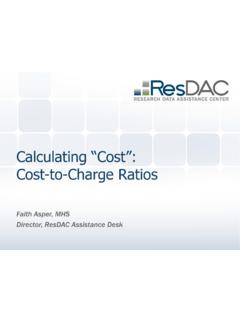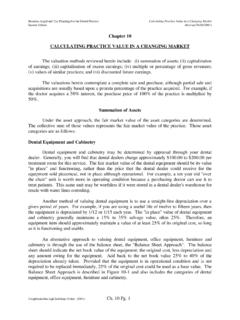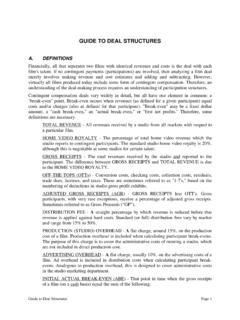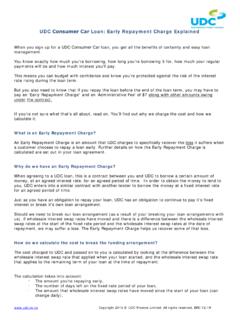Transcription of Cost Model for Biobanks - redbiobancos.es
1 BIOPRESERVATION AND BIOBANKING. Volume 11, Number 5, 2013. Mary Ann Liebert, Inc. DOI: cost Model for Biobanks M. Beatriz Gonzalez-Sanchez,1 Ernesto Lopez-Valeiras,1 Manuel M. Morente,2. and Orlando Ferna ndez Lago 3. Current economic conditions and budget constraints in publicly funded biomedical research have brought about a renewed interest in analyzing the cost and economic viability of research infrastructures. However, there are no proposals for specific cost accounting models for these types of organizations in the international scientific literature. The aim of this paper is to present the basis of a cost analysis Model useful for any biobank regardless of the human biological samples that it stores for biomedical research.
2 The development of a unique cost Model for Biobanks can be a complicated task due to the diversity of the biological samples they store. Different types of samples (DNA, tumor tissues, blood, serum, etc.) require different production processes. Nonetheless, the common basic steps of the production process can be identified. Thus, the costs incurred in each step can be analyzed in detail to provide cost information. Six stages and four cost objects were obtained by taking the production processes of Biobanks belonging to the Spanish National Biobank Network as a starting point. Templates and examples are provided to help managers to identify and classify the costs involved in their own Biobanks to implement the Model .
3 The application of this methodology will provide accurate information on cost objects, along with useful information to give an economic value to the stored samples, to analyze the efficiency of the production process and to evaluate the viability of some sample collections. Introduction to offer their products or services at no charge or at a price far below their actual production cost . Hence, in-depth I n Spain, a large number of Biobanks that hold human biological samples and associated data for research are grouped together in the Spanish National Biobank Network knowledge of costs has not been a high priority for managers.
4 3. Reduced ability to benefit from existing cost models that (ReTBioH), organized under the National Institute of Health are already implemented in hospitals and that primarily Charles III (Instituto de Salud Carlos III). The network aims value processes, not products. to coordinate, promote and harmonize the various centers 4. Heterogeneous production processes and a large variety that comprise it, and support the growth of Spanish scientific of end-products that hinder the development of a com- production in biomedicine. The new Spanish regulatory mon Model for all Biobanks . framework,1 which stipulates the basic requirements for 5.
5 Lack of disaggregated accounting information to facilitate authorization and operation of Biobanks ,2 defines Biobanks data collection for the cost analysis system. as non-profit entities. However, it allows for the possibility of cost accounting has evolved very intensely in hospitals developing a fee-per-sample structure as a way to recover in recent years, especially in the field of hospitalization, the operating and distribution costs incurred when the bio- where the development of systems based on the charac- bank sends samples out to researchers. teristics and condition of patients (case mix systems) allow In this context, the actual situation of Spanish Biobanks in for a better knowledge of hospital ,4 However, relation to cost calculation can be summarized as follows: even though studies have shown the need to have a well- 1.
6 Lack of previous work on calculating costs of tangible defined fee-per-service Model based on cost information,5. assets in the public sector in general, and in the biobank international scientific literature lacks proposals for cost sector, in particular. accounting models specifically directed towards 2. Limited economic orientation and limited attention to cost From this perspective, available studies have only analyzed analysis by biobank managers. In Spain, prior to the the costs of developing and maintaining operations at present regulatory framework, these organizations used 1. Faculty of Business Administration and Tourism; University of Vigo, Campus of Ourense, Spain.
7 2. Spanish National Cancer Centre Biobank, Madrid, Spain. 3. Complejo Hospitalario Universitario de Santiago de Compostela, Spain. 272. cost Model FOR Biobanks 273. Within this context, the Executive Committee of ReTBioH Determination of the Stages of the Production considered that its member Biobanks should have detailed Process information about their costs. So, it promoted the develop- ment of a cost calculation Model that would be applicable to The production process carried out by Biobanks varies all Biobanks and would comply with the new Spanish leg- depending on the type of sample managed: tumor tissue, islative framework.
8 To this end, ReTBioH established a DNA, blood, serum, neurological tissues, etc. However, there Working Group in cost Analysis (WGCA). The aim of this are certain basic stages that are common to the different article is to present the fundamentals of the cost analysis production processes, no matter what type of sample is methodology developed by the WGCA of ReTBioH for bio- collected. Six common stages were identified, as shown in banks. Ultimately, the proposal suggested should serve as Figure 1. the basis to successfully implement cost accounting in any As an example, in a hospital-based solid tissue bank, the given biobank.
9 First stage (collection in laboratory) could imply attaining informed consent; collecting the biological material after Design of the cost Analysis Model surgery and transporting it to the biobank laboratory; and receiving the biological material along with all of the relevant The methodology applied in analyzing and outlining the documentation. production process required the following phases of a cycle The second stage (processing of the biospecimens) could of cost analysis to be completed: involve examining and selecting the biological material for the biobanking activity (usually done by a pathologist or 1. Determination of the stages of the production process.)
10 Other trained medical personnel); freezing the biological 2. Determination of the cost objects. material in a cryomold, identifying with a code number and/. 3. Identification and classification of the costs involved in or barcode; fixing biological material and subsequently em- the calculations. bedding it in paraffin blocks; reviewing and annotating the 4. Allocation, distribution and attachment of costs to each representativeness and quality of the sample by a patholo- cost object. gist; aliquoting or carrying out other modifications, if nec- Following is a brief description of each of the four phases. essary; and annotating pre-analytical conditions.







